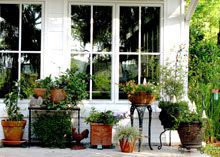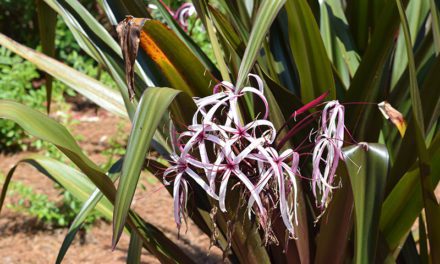 And it’s about time ! Is it just me, or did winter seem to go on forever this year? I’m ready for less pollen and fewer Live Oak leaves.
And it’s about time ! Is it just me, or did winter seem to go on forever this year? I’m ready for less pollen and fewer Live Oak leaves.
On the morning walkabout I saw there was little damage from the freezing weather this past winter. Oh, there was some burn on the leaf tips of things like the hardy ground orchids, Bletilla striata, but they bloomed reliably and new leaves will replace any damaged ones shortly. Their pleated texture will add interest for the coming months.
We are still getting citrus flowers and the pollinators were going to town on them. The enormous Carpenter bees are always the most noticeable due to their size. They are not known to be aggressive but that doesn’t stop them from trying to scare me off. It is all bluster though, no stings. They just want to do their job, which they do quite efficiently. I’ll be expecting a bumper crop of tangerines next fall thanks to them.
The hydrangeas have leafed out well, but since the deer “pruned” them for me late in the season last summer, I am not sure if there will be many flowers this year. Most Hydrangeas bloom on old wood but our growing season is so long it is possible I’ll have some late flowers – if the deer will leave them alone this year.
Velvety new leaves are emerging on the King sagos, Cycad revolute; it always amazes me that these plants have been on earth since prehistoric times. Cycads are dioecisis, meaning they have distinct male and female plants. Shortly the male plants will sport tall cones botanically known as a microsporophyll. The pollen produced in this cone will be spread by the wind to the female plant with its megasporophyll, which is shaped sort of like a flattened basketball and is covered with interesting, distinctly shaped, scales. Later in the season, large brown seeds can be seen nestled in those scales.
Caladiums like it hot and the ground soil here at my home is still a bit cool and damp. I started some tubers in black plastic nursery pots which will absorb heat from the sun. By the time the ground is warm enough, they will be large, fully grown plants, ready to transplant.
There was a bit of tea scale on a camellia, and since it was a small infestation, I just picked off all the leaves that showed any evidence and carefully raked up the mulch under the plant. A spray of Neem oil will help prevent a reoccurrence and I’ll be on high alert to make sure I caught all of the scale.
The hardy tropical plants like cannas are leafing out, and my favorite, the little Canna patens, is already blooming. Everything about this species canna is diminutive. At about 20” tall with proportionally smaller leaves, it is still a show stopper with brilliant red/orange/yellow flowers, but they too are smaller and won’t overwhelm surrounding plants.
We all know fall is the best time to plant in this area, but who can resist the new plants our nurseries are showing. The Heucheras, my favorite native plant, are good for just about any garden setting. Use them in containers, massed in beds, as feature plants – just anywhere. They are evergreen, drought tolerant, and most can handle sun and shade. (Always read the label.) All this and the new hybrids, also called nativars, come in an amazing variety of colors, shapes and sizes! I am going to look for a variety called Dolce Cinnamon Curls, which has large, wavy red leaves.
Some interesting succulents with their low water needs are also on my list. A few pots stuck here and there will add interest but will require little attention.
Speaking of water needs, the rain sensor on my automatic irrigation system appears to need replacing. The sprinklers came on right after we experienced a heavy rain. The sensor should have overridden the timer if it was working properly. This is an inexpensive, easily replaced part. No sense in wasting water. The rule of thumb is our plants need 1” of water a week, and one long, slow watering is better for developing the deep roots necessary for healthy plant growth as opposed to several short 15 minute bursts.
Well, it is time to rake the leaves again; not everything about spring is wonderful.







